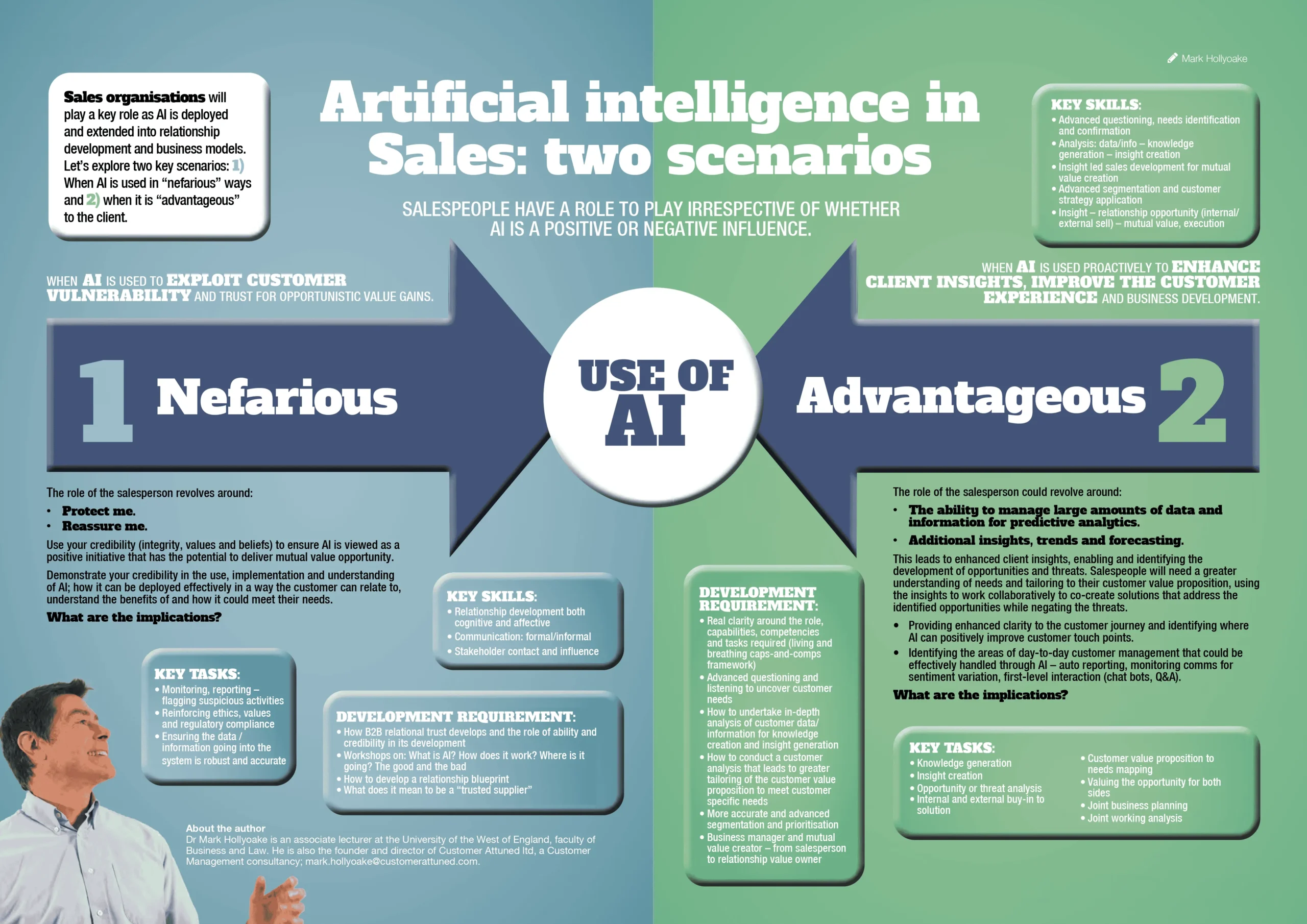Artificial intelligence in Sales: two scenarios
30th September 2024 | Mark Hollyoake
Salespeople have a role to play irrespective of whether AI is a positive or negative influence.
Sales organisations will play a key role as AI is deployed and extended into relationship development and business models. Let’s explore two key scenarios: 1) When AI is used in “nefarious” ways and 2) when it is “advantageous” to the client.

1 Nefarious
WHEN AI IS USED TO EXPLOIT CUSTOMER VULNERABILITY AND TRUST FOR OPPORTUNISTIC VALUE GAINS.
The role of the salesperson revolves around:
- Protect me.
- Reassure me.
Use your credibility (integrity, values and beliefs) to ensure AI is viewed as a positive initiative that has the potential to deliver mutual value opportunity.
Demonstrate your credibility in the use, implementation and understanding of AI; how it can be deployed effectively in a way the customer can relate to, understand the benefits of and how it could meet their needs.
What are the implications?
KEY SKILLS:
- Relationship development both cognitive and affective
- Communication: formal/informal
- Stakeholder contact and influence
KEY TASKS:
- Monitoring, reporting – flagging suspicious activities
- Reinforcing ethics, values and regulatory compliance
- Ensuring the data / information going into the system is robust and accurate
DEVELOPMENT REQUIREMENT:
- How B2B relational trust develops and the role of ability and credibility in its development
- Workshops on: What is AI? How does it work? Where is it going? The good and the bad
- How to develop a relationship blueprint
- What does it mean to be a “trusted supplier”
2 Advantageous
WHEN AI IS USED PROACTIVELY TO ENHANCE CLIENT INSIGHTS, IMPROVE THE CUSTOMER EXPERIENCE AND BUSINESS DEVELOPMENT.
The role of the salesperson could revolve around:
- The ability to manage large amounts of data and information for predictive analytics.
- Additional insights, trends and forecasting.
This leads to enhanced client insights, enabling and identifying the development of opportunities and threats. Salespeople will need a greater understanding of needs and tailoring to their customer value proposition, using the insights to work collaboratively to co-create solutions that address the identified opportunities while negating the threats.
Providing enhanced clarity to the customer journey and identifying where AI can positively improve customer touch points. Identifying the areas of day-to-day customer management that could be effectively handled through AI – auto reporting, monitoring comms for sentiment variation, first-level interaction (chat bots, Q&A).
What are the implications?
KEY SKILLS:
- Advanced questioning, needs identification and confirmation
- Analysis: data/info – knowledge generation – insight creation
- Insight led sales development for mutual value creation
- Advanced segmentation and customer strategy application
- Insight – relationship opportunity (internal/ external sell) – mutual value, execution
KEY TASKS:
- Knowledge generation
- Insight creation
- Opportunity or threat analysis
- Internal and external buy-in to solution
- Customer value proposition to needs mapping
- Valuing the opportunity for both sides
- Joint business planning
- Joint working analysis
DEVELOPMENT REQUIREMENT:
- Real clarity around the role, capabilities, competencies and tasks required (living and breathing caps-and-comps framework)
- Advanced questioning and listening to uncover customer needs
- How to undertake in-depth analysis of customer data/ information for knowledge creation and insight generation
- How to conduct a customer analysis that leads to greater tailoring of the customer value proposition to meet customer specific needs
- More accurate and advanced segmentation and prioritisation
- Business manager and mutual value creator – from salesperson to relationship value owner

